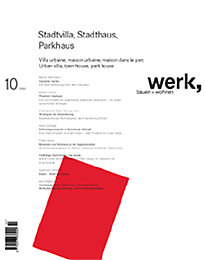Editorial
A good year ago now, wbw brought up the question of contemporary „normality“ in housing. Central to this was a search for solutions that cover as many requirements as possible. Criticisms were made of average housing production that scarcely allows for new ways of living, despite the enormous changes that our society is going through. This reluctance applies equally to the people who use the homes as to architects who enjoy experimenting. And so as a kind of response to this we are following up with an issue about housing construction that addresses particular requirements. So we are changing our point of view and joining in the debate about promoting individual forms of living in cities. A great deal of importance is attached to the question of whether it is possible to overcome the functional constraints of the standard floor plan successfully. Here we are looking at homes for the self-confident and demanding middle classes. For some time now an increasing number of tenants and purchasers have been rediscovering the city as an attractive place to live. They accept that these advantages are available only with a high level of urban density. This density itself is currently being re-assessed. Architects prove that its disadvantages can be counteracted by good proposals in plan and section. In fact some exciting things are being generated by this new situation: the ancient task of housing needs to be attacked differently, thought through in a completely new way, indeed reinvented to a certain extent. The art of „getting past each other“ and participating in urban life without obligation is being varied by playing a game with access and screening off private areas; external links with the neighbourhood, urban green spaces and the sky are staged carefully, and as individually as possible. These ideas run directly counter to the communal housing projects of the seventies and eighties. Today, the interior is the principal focus of attention; buildings are essentially developed from the way they are lived in: self-realization and a personal life-style are to be promoted; homes should be unique; they should make special provision for different times of life, different financial positions and personal preferences. Politicians are also very interested in housing construction of this kind: good taxpayers and people who form the political basis for a middle-class life-style are to be lured out of their suburban homes and into the city. Housing that responds to their demands with special qualities in terms of the accommodation offered and the immediate neighborhood is an essential requirement here. This new „liberated living“ in urban villas, town houses and park houses requires a certain excess of living space. It is not least for this reason that the effect these new developments will have on housing construction in general is uncertain. Experts state pessimistically that there is practically no stimulus to experiment for developers because of the spectacular housing shortage in the Swiss conurbations. The new housing that is on offer is afraid to take risks and is imprisoning its occupants in the dictates of their conservatism. And yet: we are seeing the first signs that both social housing and also major (Dutch) developers are starting to take an interest in making housing more individual.
Irma Noseda (Translation: Michael Robinson)
